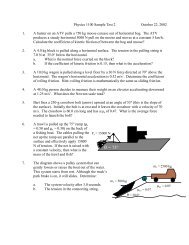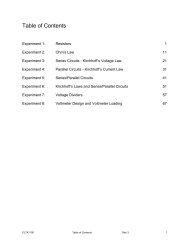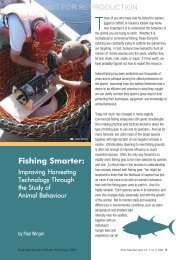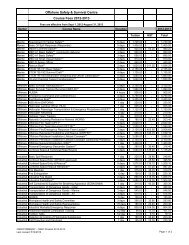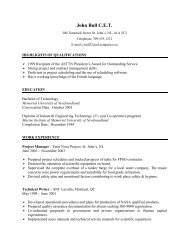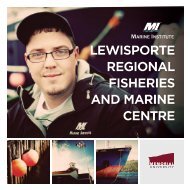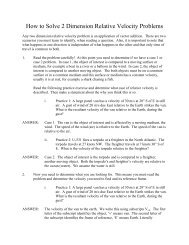Academic Calendar - Fisheries and Marine Institute - Memorial ...
Academic Calendar - Fisheries and Marine Institute - Memorial ...
Academic Calendar - Fisheries and Marine Institute - Memorial ...
You also want an ePaper? Increase the reach of your titles
YUMPU automatically turns print PDFs into web optimized ePapers that Google loves.
COURSE DESCRIPTIONS<br />
NASC 3201 (GMDSS)<br />
This is a comprehensive course which enables radio station<br />
personnel, ashore <strong>and</strong> afloat, operating in accordance with<br />
the Global Maritime Distress <strong>and</strong> Safety System (GMDSS) to<br />
utilize efficiently all aspects of the GMDSS communications<br />
matrix. In addition, this course adheres to the fundamental<br />
recommendations for training of maritime radio personnel as<br />
outlined in the International Maritime Organization’s Resolution A.<br />
703(17).<br />
The Global Maritime Distress <strong>and</strong> Safety System (GMDSS);<br />
Regulations <strong>and</strong> Publications Pertaining to the GMDSS; Radio<br />
Theory; Practical Radio Communication Operations on VHF/MF/<br />
HF; Digital Selective Calling (DSC); Practical DSC Procedures<br />
on VHF/MF/HF; Inmarsat; Practical Inmarsat Communication<br />
Procedures on Inmarsat A <strong>and</strong> C; Enhanced Group Calling<br />
(EGC) Telex Over Radio (TOR); NAVTEX; Power Supplies &<br />
Maintenance; Emergency Position Indicating Radio-Beacon<br />
(EPIRB); Search <strong>and</strong> Rescue Radar Transponder (SART)<br />
Prerequisite - NASC 2107 (Restricted Operator’s Certificate<br />
-Maritime Commercial)<br />
Duration - 10 days<br />
Lectures/Practical Exercises - 6.5 hours/day = 65 hours total<br />
NASC 3208 (Stability III)<br />
This advanced level course links stability theory with practical<br />
applications. Drawing on the student’s knowledge of cargo<br />
operations <strong>and</strong> vessel stability criteria, this course will, through<br />
calculations, enhance the student’s ability to optimize cargo<br />
distribution <strong>and</strong> to provide adequate statical <strong>and</strong> dynamical<br />
stability for a vessel’s safe passage..<br />
Damage Stability; Grounding <strong>and</strong> Docking; Pressure Exerted by<br />
a Liquid; Vessel Stresses; Longitudinal Strength; M. V. Atlantic<br />
Vision <strong>and</strong> M.V. Gypsum Centennial; Ship Motions; Cargo<br />
Loading <strong>and</strong> Stress Measuring Instruments <strong>and</strong> Software<br />
Prerequisites - WKTM 2102 (Sea Phase II - Nautical Science);<br />
NASC 3108 (Stability)<br />
Duration - 13 weeks<br />
Lectures/Work Periods - 4 hours/week = 52 hours total<br />
NASC 3300 (Seamanship)<br />
This course is designed to give students an advanced knowledge<br />
<strong>and</strong> underst<strong>and</strong>ing of the techniques required to be an efficient<br />
<strong>and</strong> responsible ship h<strong>and</strong>ler, <strong>and</strong> to prepare students to be<br />
observant cargo officers who are prepared to make cargo lashing<br />
adjustments if <strong>and</strong> when necessary.<br />
Ship H<strong>and</strong>ling; Heavy Lifts <strong>and</strong> Cargo Lashing; On Board<br />
Practical Training<br />
Prerequisites - NASC 3103 (Seamanship); WKTM 2102 (Sea<br />
Phase II - Nautical Science)<br />
Duration - 5 weeks<br />
Lectures/Laboratories - 9 hours/week<br />
NASC 3303 (Bridge Watchkeeping)<br />
Bridge watchkeeping is the most important activity conducted<br />
at sea. The Officer of the Watch (OOW) is the Master’s<br />
representative <strong>and</strong> is responsible for the security of the ship <strong>and</strong><br />
all those aboard. The OOW needs to be proficient in navigation,<br />
have a fluent underst<strong>and</strong>ing of the Collision Regulations,<br />
know how to use the radar/ARPA, be familiar with the bridge<br />
instruments, know the ship <strong>and</strong> its routines, be able to respond to<br />
emergencies, h<strong>and</strong>le communications, maintain records correctly<br />
<strong>and</strong> be able to work as a member of the bridge team. This<br />
course provides students with an opportunity to build on previous<br />
knowledge <strong>and</strong> training <strong>and</strong> to practice watchkeeping skills in a<br />
simulated environment.<br />
Introduction; Manoeuvring Data; Bridge Organization; Voyage<br />
Preparation; Officer of the Watch (OOW); Emergencies;<br />
Simulation<br />
Prerequisites - WKTM 2102<br />
Duration - 8 days (56 hours)<br />
OMAP 2000 (Underwater Acoustic Applications)<br />
This course is designed to introduce students to the principles<br />
<strong>and</strong> applications of acoustic remote sensing with specific<br />
emphasis on its utilization in the marine environment.<br />
Introduction; Principles; Applications<br />
Prerequisites - PHYS 1100<br />
Duration - 13 weeks<br />
Lectures - 2 hours/week = 26 hours total<br />
Laboratories - 2 hours x 5 = 10 hours total<br />
OR<br />
Duration - 5 weeks<br />
Lectures - 5 hours/week = 25 hours total<br />
Laboratories - 2 hours x 5 = 10 hours total<br />
OMAP 2200 (Side Scan Sonar <strong>and</strong> Geophysical<br />
Remote Sensing)<br />
This course provides the student with an introduction to<br />
the theoretical, technical <strong>and</strong> practical application of Side<br />
Scan Sonar <strong>and</strong> Geophysical Remote Sensing systems <strong>and</strong><br />
techniques. The course will be taught using modern equipment<br />
<strong>and</strong> methodologies, allowing the student to better underst<strong>and</strong> the<br />
benefits <strong>and</strong> limitations associated with this technology, from data<br />
acquisition to data dissemination.<br />
Introduction to Side Scan Sonar; Fundamentals of Underwater<br />
Acoustics; Side Scan Sonar Fundamentals; Side Scan Sonar<br />
Survey Techniques; Trends in Side Scan Sonar Technology;<br />
Introduction to Sub Bottom Profiling; The Sub Bottom Record;<br />
Return Signal Amplification; Sub Bottom Profiler Design<br />
Characteristics; Underwater Acoustic Environments; Sub Bottom<br />
Profiler Data Interpretation; Trends in Sub Bottom Profiler<br />
Technology; Introduction to Magnetometers; Principles of<br />
Magnetometer Surveys; Magnetic Survey Data; Magnetic Survey<br />
Problems; Combined Side Scan Sonar <strong>and</strong> Magnetometer<br />
Surveys; Side Scan Sonar <strong>and</strong> Magnetometer Towing Best<br />
Practices; Introduction to <strong>Marine</strong> Gravimetry<br />
189






